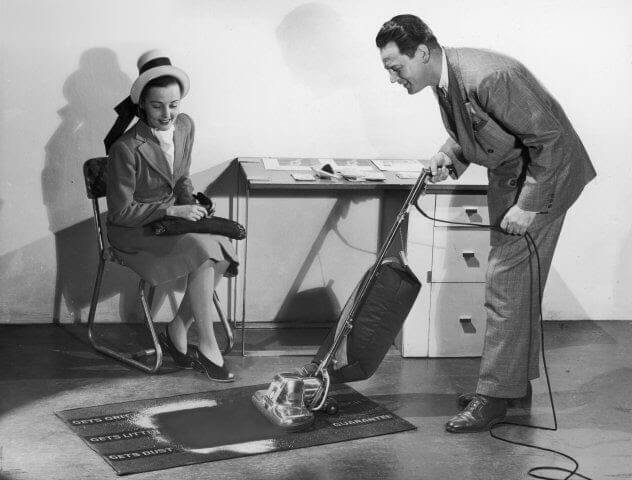[Scene opens on an idyllic suburban neighborhood where a salesman in an ill-fitting suit and sporting well-greased hair approaches the door of a quaint, one-story brick home.]

[Man knocks. A cheerful yet cautious woman opens the door. ]
Salesman: “Hello Ma’am! I‘m from Acme Vacuums! I’m ready to delight you with our awesome cleaning products!”
[Woman goes from cautious to very suspicious, like a rabbit listening to a lipstick pitch from a fox.]
Woman: “Well, I already use the Wiley Electro Mop. It works fine. It has five interchangeable nozzles.”
Salesman: “Oh dear, oh dear! Only five Nozzles!”
[Man projects the kind of incredulousness that only comes from being very used to being incredulous.]
“Well, you’re lucky I’m here. Those new houses round the corner all use our seven-nozzle version. It’s a good thing I got to you in time, before the dirt overcame you entirely!”
[Man looks at woman pityingly]
Woman: “But I don’t need seven nozzles. That’s too much suction for my house. And I would have to teach my husband how to use it. That could take a while…”
Salesman: “Ma’am, why don’t we go inside and I can describe in detail the training plans we have in place to assist people like your husband. Fear not! You are not alone on this journey to cleanliness!”
[Woman is offended and angry.]
Woman: “My house was clean before you got here and will be clean afterwards… Go away!”
[Door slams.]
[Man goes into his case, puts on a mask and practices a new accent. Knocks.]
——-
For some, selling software can be a lot like this depiction of a door-to-door vacuum cleaner salesman from the Fifties. It’s all about the vacuum and its features and nothing about the house.
What we sell at Chef is a new way of operating your business. A way that delivers better targeted product to your customers faster than ever before. We have a tool, called Chef, which makes some of this possible. But to complete the journey, you need to be ready to work hand-in-hand with us to change how you operate, and, more importantly, how you leverage the resources and creativity of your technical professionals. It isn’t about buying yet another tool. No matter how cool. And no matter how many cool companies are already using it.
Since the Nineties, the core of non web-based businesses (banking, manufacturing etc.) have been defined by three basic trade-offs:
– Investing in being more efficient.
– Investing in knowing more about your customer.
– Investing in your product.
System investments often underpinned these. We have tried business process re-engineering, CRM systems and various other initiatives to make us better at these things. The basic problem is that the efficiencies reaped in one area were, at best, very inefficiently translated into benefits to the others. For instance, how often have you seen a product department keep up with requests from customer-facing staff on new features?
And yet, web companies seem to be pretty good at tying these ideas together. The more quickly they can get features on to the site, the faster they can get customers to use them / pay for them, and the more efficient their use of infrastructure becomes. So how can a ‘traditional’ large enterprise get there? Is it possible for a horse to become a unicorn?
Automation as a basic organizing principle for technology has some surprising implications for the business model itself. Traditional enterprise value is moving from a functional to a relational viewpoint. Consider this:
In service of efficiency you standardize on some basic infrastructure and by doing it consistently every time, you lower your cost of compliance too. This frees up your IT staff, auditors, compliance people, lawyers, etc. from wasting time on checking the basics, so that they can focus on innovative new features to add to your products.
Of course, this ability to trust standard invariant processes and infrastructure means that you also waste less time preparing to execute and more time actually getting your product to market. This means that you get to the customer very quickly and can make changes that reflect their concerns rapidly.
This, in turn, ensures that you understand customer demand and the abilities of your products and platforms to scale effectively – allowing you to better understand your cost basis, and so on… the cycle continues.

This is obviously a very simplified example but certainly illustrates the general idea that in some circumstances the forces of Consistency, Speed and Scale can become a virtuous cycle constantly reinforced by feedback from customers. Automation is what makes it possible.
Ironically, automation is also what makes it safer. Automation is a basic organizing principle that transmits value across your enterprise. It does this by forcing you to standardize. You have to have something invariant if you want it everywhere. The degree and extent of standardization is a very good proxy for the rate of change that you are promoting in your organization because making changes to the standard way things are built is the primary reason for organizational push-back. Being able to ‘regulate’ this change as you get better at explaining the changes and showing the benefits is a very important by-product.
Chef, as a company, wants to help businesses get to the point where that virtuous cycle, the so-called “Automation Value Cycle” is at work in your business. Now THAT will make you a differentiated actor in your market.
So, we don’t sell vacuum cleaners, we sell the ability to create a better home.
We sell neighborhood envy.

